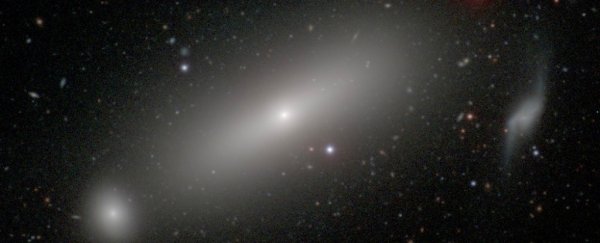Just because we don't have an actual picture of one yet, doesn't mean that researchers aren't constantly trying to figure out what the hell is going on with black holes, and it's easy to see why.
These massive objects, which commonly lie at the centre of galaxies, are the rock stars of astrophysics - not only are they the subject of debate between some of the world's greatest minds, they're also prominent figures in science fiction.
Now, us black hole fans have something new to get excited about, because an international team of researchers just announced that they've managed to measure the mass of one inside NGC 1332 - a galaxy that lies 73 million light-years away. This is one of the most accurate measurements of a black hole's mass ever.
According to the team, which used the Atacama Large Millimetre/submillimetre Array (ALMA) in Chile for their analysis, the black hole inside NGC 1332 is 660 million times more massive as the Sun, and has a cloud of gas circling it at roughly 1.8 million kilometres per hour (about 1.1 million miles per hour).
Measuring the speed of this spin is crucial - knowing how fast the dense, cold clouds orbiting the black hole are spinning can tell you a lot about the black hole's mass in the centre, based on its gravitational pull.
And while these clouds emit no light for astronomers to detect, they glow brightly at wavelengths that ALMA can pick up.
"This is the first time that ALMA has probed the orbital motion of cold molecular gas well inside the gravitational sphere of influence of a supermassive black hole," said one of the researchers, Aaron Barth from the University of California, Irvine. "We are directly viewing the region where the cold gas is responding to the black hole's gravitational pull."
Understanding these supermassive black holes will give us insights into how galaxies form as a whole. Right now, researchers are limited by technology because it's notoriously hard to find black holes, despite all of their insane properties. The new measurement shows that this technology is getting better, and pushing our understanding of the Universe higher along with it.
"Part of understanding supermassive black holes is measuring their exact masses. That lets scientists determine if a black hole is growing faster or slower than its galaxy. If black hole mass measurements are inaccurate, scientists can't draw any definitive conclusions," said one of the team, Andrew J. Baker of Rutger's University.
"This has been a very active area of research for the last 20 years, trying to characterise the masses of black holes at the centres of galaxies," he adds. "This is a case where new instrumentation has allowed us to make an important new advance in terms of what we can say scientifically."
The team published their findings in The Astrophysical Journal Letters.
